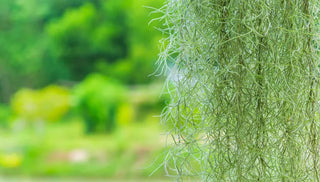Let’s dive into the enchanting world of Spanish Moss (Tillandsia usneoides), a staple of Southern Gothic imagery and an intriguing species in the world of air plants. Despite its name, it's not actually a moss but an epiphytic bromeliad native to the Southeastern United States, Central America, South America, and the Caribbean. Spanish Moss gracefully drapes from tree branches, creating a mystical and ethereal appearance. It’s renowned for its slender, thread-like appearance and silvery-gray color, adding a unique texture and visual interest to any setting.
Choosing Your Spanish Moss
Spanish Moss is generally hardy and low-maintenance, making it a great choice for gardeners of all levels. There aren’t significant variations in types, but you might find slight differences in color and length.
How to Care for Spanish Mosses
Light
Spanish Moss prefers bright, filtered light. Direct sunlight can be too harsh, especially in hotter climates, so partial shade is ideal. If grown indoors, a spot near a window with indirect light works well.
Soil
Spanish Moss doesn’t require soil to grow as it absorbs nutrients and moisture through its leaves from the air. This makes it incredibly versatile in how it can be displayed.
Fertilizer
While not necessary, you can give your Spanish Moss a boost with a diluted, balanced liquid fertilizer (preferably formulated for bromeliads) once a month during the growing season.
Watering
In outdoor settings, Spanish Moss usually gets enough moisture from rain and humidity. Indoors, mist it thoroughly once a week or more often if the air is dry. Ensure it dries out between waterings to prevent rot.
Pruning
Pruning isn’t necessary, but you can trim it to maintain your desired shape or size. Use clean scissors to prevent any disease transmission.
Repotting
Repotting isn’t applicable to Spanish Moss since it doesn’t grow in soil. However, you can rearrange or rehang it as desired for aesthetic purposes.
Propagation
Propagating Spanish Moss is simple. Just take a small piece and place it in the desired location. It will naturally start to grow and absorb nutrients from the air.
Common Problems with Spanish Mosses
Pests and Diseases
The most common issue is rot due to excessive moisture. Ensure it dries properly after watering. Pests are rare, but watch for any signs of scale or mites.
Toxicity
Spanish Moss is not toxic, making it safe around pets and humans.
Spanish Moss FAQs
Can Spanish Moss survive indoors?
Yes, it can thrive indoors if it receives enough light and proper moisture. Hanging it near a window where it gets indirect sunlight is ideal.
How do I revive dried Spanish Moss?
If it’s not too far gone, you can revive dried Spanish Moss by soaking it in water for a few hours and then letting it dry out completely.
Does Spanish Moss need to be fertilized?
Fertilization isn’t necessary, but a light feeding during the growing season can promote fuller, healthier growth.
Caring for Spanish Moss is a delightful experience, adding a unique and mystical touch to your garden or home. Its low-maintenance nature makes it perfect for gardeners of any level, looking to add a bit of Southern charm to their surroundings.




